What Are the Government Standards for Building a Beef Cattle Barn
Introduction
In New England, beef enterprises are cow/calf, feeder, or a combination of both. Moo-cow/calf enterprises commonly require less financial investment in facilities than feeder operations. Feeder cattle facilities crave more solitude pens, more than automation of feeding systems and less need for roofed shelters. Each type of facility must exist designed appropriately.
Several different designs for housing and handling facilities are suitable for beef operations taking into consideration the weather, topography, and the availability of feed and pasture. Information technology is important to know all the rules and regulations with respect to location, design, and type of functioning. Check with your local Edifice Inspector to obtain the required permits prior to building or renovating your existing facility. You should likewise talk to an experienced builder or contractor to ensure the cost of the facility is within the objectives of the functioning.
It is important to choose a location for buildings and handling facilities that is on well-tuckered soil with properly designed surface water drainage situated away from streams, other bodies of water and is not close to population centers. Cheque with your canton Natural Resources and Conservation Service (NRCS) office for recommended guidelines.
Some Recommended Structures for Beefiness Cattle Housing
Open up sided, single slope roof shed
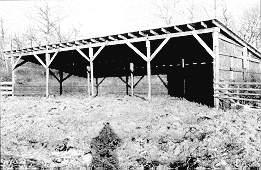
This type of housing is most typical of structures used and is suitable for all cattle on the farm. This is the least expensive of new structures and very easy to build. Open sheds should face the southward for wintertime sunday and block the prevailing winds. Pole barns of this design can be partitioned for groups of animals without complicated interior construction.
Open sided, clear span pole shed

The articulate span provides more space for equipment to remove manure and thus any side of the building can be open to the surround. The gable terminate of the befouled is recommended to be open then that the belch of rain and snow is not over the open side of the building. When the gable end is open, the bays areas are usually deeper and provide more than protection from the wind. The back end of the construction may be nighttime and clammy and may need additional design attending for ventilation and lighting. This type of housing is more practical for smaller sized herds (under 20 head of cattle).
Old Dairy Barns
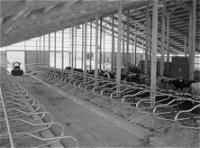
Today at that place are many unused dairy barns due to dairy farmers either retiring or dispersing. The renovation costs are normally less than the price of a new structure. Lighting and ventilation are usually adequate in former dairy facilities for use by beefiness cattle. Manure removal is a major piece of the renovation programme. Conventional tie stalls that are used on New England dairy farms with a gutter are non recommended. Free stall barns are the platonic dairy facility for use with beefiness cattle since the manure handling is already set-up.
Hoop Barns
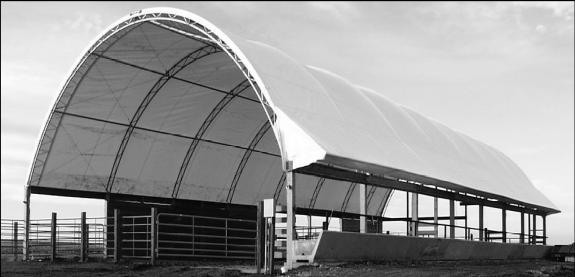
One of the least expensive structures for housing cattle is the hoop barn. Hoop barns are similar to greenhouses. One disadvantage is the heat and ventilation problems during the summer months, but this should not pose an result if you lot are planning on grazing your cattle during the warmer climate months.
Feeding Equipment
Feed Bunks

The main requirements for feed bunks are that they are applied, proficient quality, rugged, and economic. The bunk length and capacity should meet livestock requirements.
Portable Hay Feeders
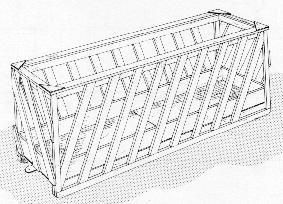
This portable feeder is a proven hay-saving design for gratuitous-choice supplementary hay feeding in a field, feedlot, or loose housing barn. The sloping spacers allow cattle of varying sizes to feed comfortably with their heads within the feeder. This helps to reduce waste product since cattle do non have to withdraw their heads to stand and chew.
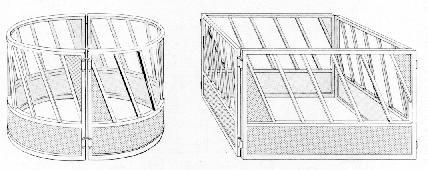
Round and big bale feed racks are piece of cake to load, move, and as well foreclose hay wastage. The round version requires a bender to reform the foursquare tube rails, but the round shape makes it easier to roll it from place to place. The foursquare version is easier to build in the farm shop, and information technology can be completely collapsed for transport in a pickup truck. Of import feed- saving features are the solid lower section and the slanted divider bars to a higher place.
H2o Equipment
Many watering equipment organisation options are bachelor. Unlike systems may exist used throughout the twelvemonth. If you are grazing animals, you may want portable water tanks to reduce the impact of cattle in one location. In the winter, depending upon your climate, you lot may need heated units for use in pasture. There are many things to consider when selecting a organisation for employ on your farm. The most of import factor to understand your livestock' water needs and ensure that the current system can run into those requirements.
Headgate
The headgate is the well-nigh important part of the unabridged working facility. Information technology should be sturdy, safe, easy to operate, and work smoothly and quietly. Headgates come in four basic types; self communicable, scissors-stanchion, positive-control and fully opening stanchion. The cocky-communicable headgate closes automatically due to the movement of the animal. The scissors-stanchion type has biparting halves that pivot at the bottom. The positive-control type locks firmly around the animal's neck. The fully opening stanchion consists of two biparting halves that piece of work like a pair of sliding doors. The self-catching, scissor-stanchion and the fully opening stanchion are available with either directly or curved stanchion confined. The directly-bar stanchion is extremely safe and will rarely asphyxiate an brute. The disadvantage is animals can move their heads upward and downwards unless a nose bar is used. The curved-bar stanchion offers more control of the animal'south caput just is more probable to asphyxiate the animal than the straight-bar type. Both types are safer than the positive-control headgate. No affair which type of headgate is selected, proper aligning for the type of cattle being worked is necessary to prevent injury to the animals.
Property Chute
The holding chute is secured to the head gate and located immediately behind it. The property chute should generally not be any wider than 26 inches but should exist adjustable in club to compensate for different-size animals. The sides should be solid and so that animals are non able to look out and exist scared by their surroundings.
Working Chute
The working chute connects the belongings chute with the holding pen. It should be long plenty to hold five to six animals at a time.
Crowding Pen
The crowding pen is located at the back of the working chute. Size should be near 150 foursquare anxiety. This area volition hold five or six caput of cattle.
Holding Pens
Holding pens should mesh conveniently with the rest of the facility. Each belongings pen should provide approximately 20 square feet of space per animal.
Scales
Scales are optional depending on your size functioning but can be useful in weighing cattle. The scales should exist located and so cattle can be easily moved on and off. Practice not locate scales in highly trafficked areas.
Loading Chute
The loading chute may be optional if a trailer is used to transport animals. The loading chute should be located direct off the crowding pen.
Determination
While improving your ability to handle cattle efficiently and safely does cost both time and coin, it is an investment that provides an excellent an often immediate return. A number of options are available if you want to install a new facility or improve an existing one, enabling y'all to better your facility so that information technology meets your needs without exceeding your resource.
Notation: As a rule, all ages of cattle tin can stay on pasture during the warm weather months. Pastured or grass fed beef is a growing tendency with New England beef producers and the consumer's need for this product is increasing.
Note: A ane or two-sided structure with a roof can provide shelter to cattle during periods of intense cold. Structures should be congenital with the open sides facing the s or eastward (depending upon prevailing winds) to maximize effects of solar radiation during the winter.
Note: Cattle on average tin can consume 1 gallon of h2o per 100 pounds live weight per day.
Resources
Regime of Saskatchewan Agronomics. "Beefiness Cattle Housing and Feedlot Facilities". 2008.
Source: https://ag.umass.edu/crops-dairy-livestock-equine/fact-sheets/beef-cattle-housing-equipment
0 Response to "What Are the Government Standards for Building a Beef Cattle Barn"
Post a Comment